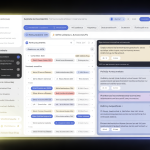
AI-Powered Demand Forecasting Tool for Retail Businesses
One common frustration for retail businesses is the difficulty of accurately forecasting product demand.
This can lead to stockouts or overstock situations, impacting sales and profitability.
An AI-powered demand forecasting tool for retail businesses could analyze various data points such as historical sales data, market trends, weather conditions, and promotions to predict future demand with high accuracy.
By using machine learning algorithms, the tool can continuously improve its forecasts based on new data.
Retailers can then optimize their inventory levels, pricing strategies, and marketing campaigns based on these predictions, ultimately leading to increased efficiency and better customer satisfaction.
Risks and Challenges: What potential challenges are anticipated? How to overcome them?
Some potential challenges to consider with the AI-powered demand forecasting tool for retail businesses include data accuracy and quality, algorithm bias, and user adoption.
To overcome these challenges, it is crucial to ensure clean and relevant data inputs, regularly validate and refine the machine learning algorithms to minimize biases, and provide user-friendly interfaces and training to encourage adoption among retail stakeholders.
Additionally, incorporating feedback loops and monitoring systems can help identify and address any issues that may arise during implementation and usage of the tool.
Scalability: How can this startup idea scale? What are the steps to grow this business?
To scale this startup idea, the first step would be to validate the demand forecasting tool with early adopters and gather feedback for continuous improvement.
Next, focus on expanding the customer base by targeting retail businesses of various sizes across different industries.
Develop strategic partnerships with retail platforms or software providers to integrate the tool seamlessly.
Invest in sales and marketing efforts to increase awareness and reach in the market.
As the business grows, consider offering additional features, customizations, and support services to cater to the evolving needs of retail businesses.
Ultimately, building a strong brand reputation and delivering tangible results will be key to scaling this startup successfully.
MVP: What could be the simplest, functional version of the product that still addresses the problem? What might be the timeline to bring it to market?
The simplest, functional version of the product could be an AI-powered demand forecasting tool that analyzes historical sales data to predict future demand for retail businesses.
This MVP could exclude more complex data points such as market trends, weather conditions, and promotions initially to streamline the development process.
The timeline to bring this MVP to market could be around 6-9 months, depending on the availability of data for training the machine learning algorithms and the complexity of the technical implementation.
Solution #1
An AI-powered demand forecasting tool for retail businesses could analyze various data points such as historical sales data, market trends, weather conditions, and promotions to predict future demand with high accuracy.
By using machine learning algorithms, the tool can continuously improve its forecasts based on new data.
Retailers can then optimize their inventory levels, pricing strategies, and marketing campaigns based on these predictions, ultimately leading to increased efficiency and better customer satisfaction.
Solution #2
Implementing a demand sensing solution that leverages real-time data such as point-of-sale information, social media mentions, competitor activity, and economic indicators to provide retailers with up-to-the-minute demand forecasts.
This dynamic approach can help retailers quickly adjust their inventory levels, pricing strategies, and promotions in response to changing market conditions, reducing the risk of stockouts or overstock situations and maximizing sales opportunities.
Solution #3
Utilizing advanced analytics and data integration to create a demand forecasting model that incorporates customer behavior data, such as purchase history, preferences, and browsing patterns, in addition to traditional sales data.
By analyzing customer insights alongside other key factors like market trends and external influences, retailers can enhance the accuracy of their demand forecasts and tailor their product offerings, pricing strategies, and marketing efforts to better meet the needs and expectations of their target audience.
This customer-centric approach can help retailers anticipate demand fluctuations more effectively and improve overall business performance.


